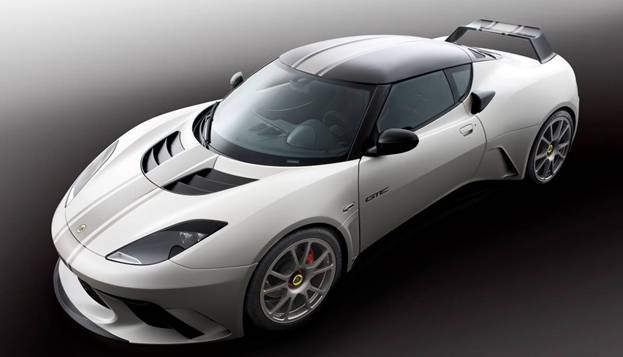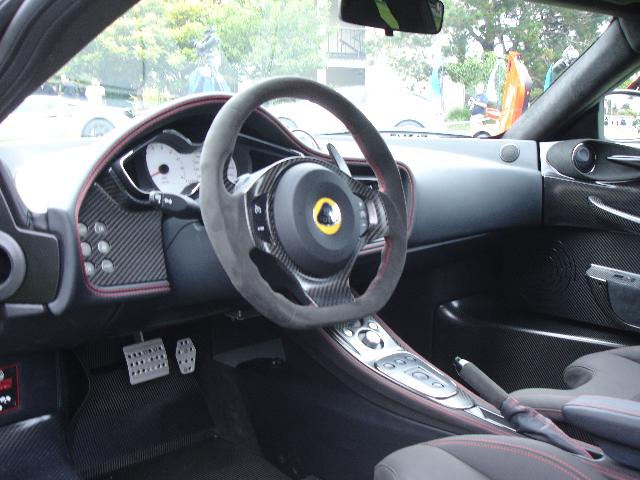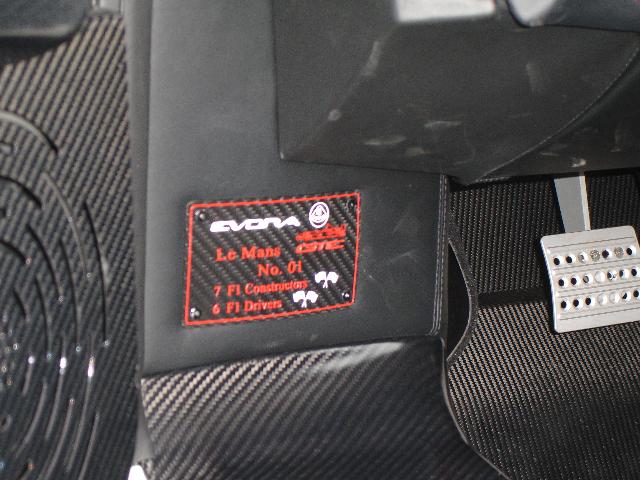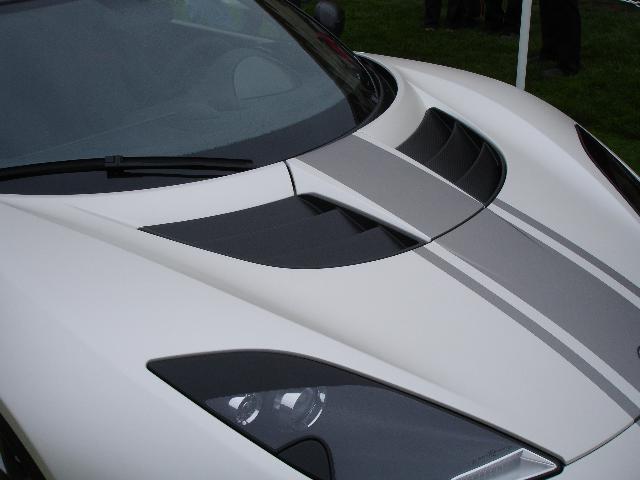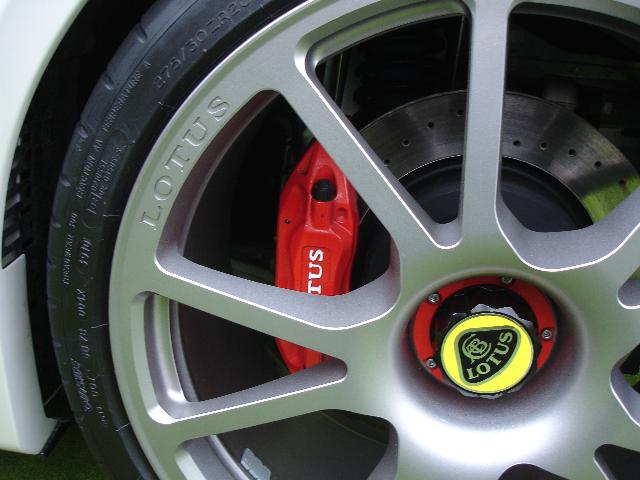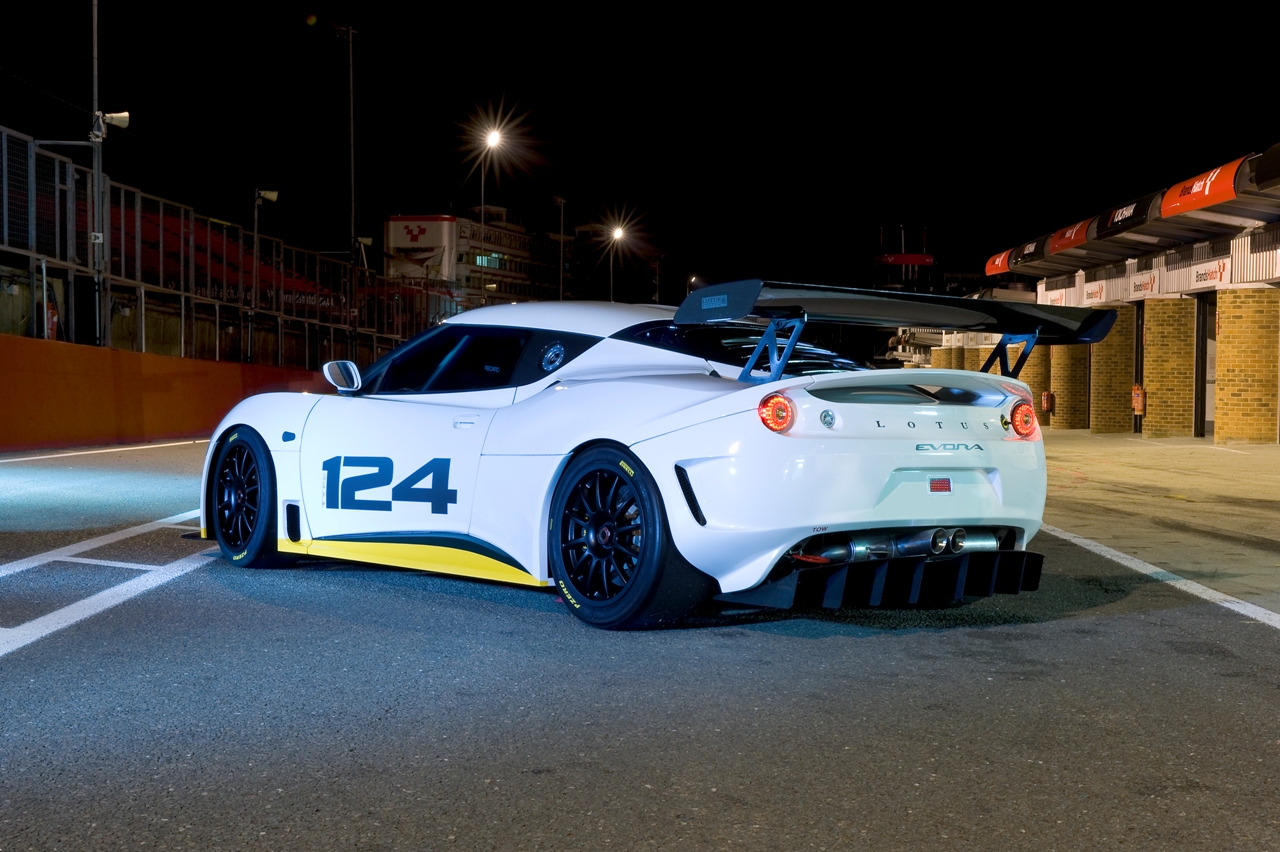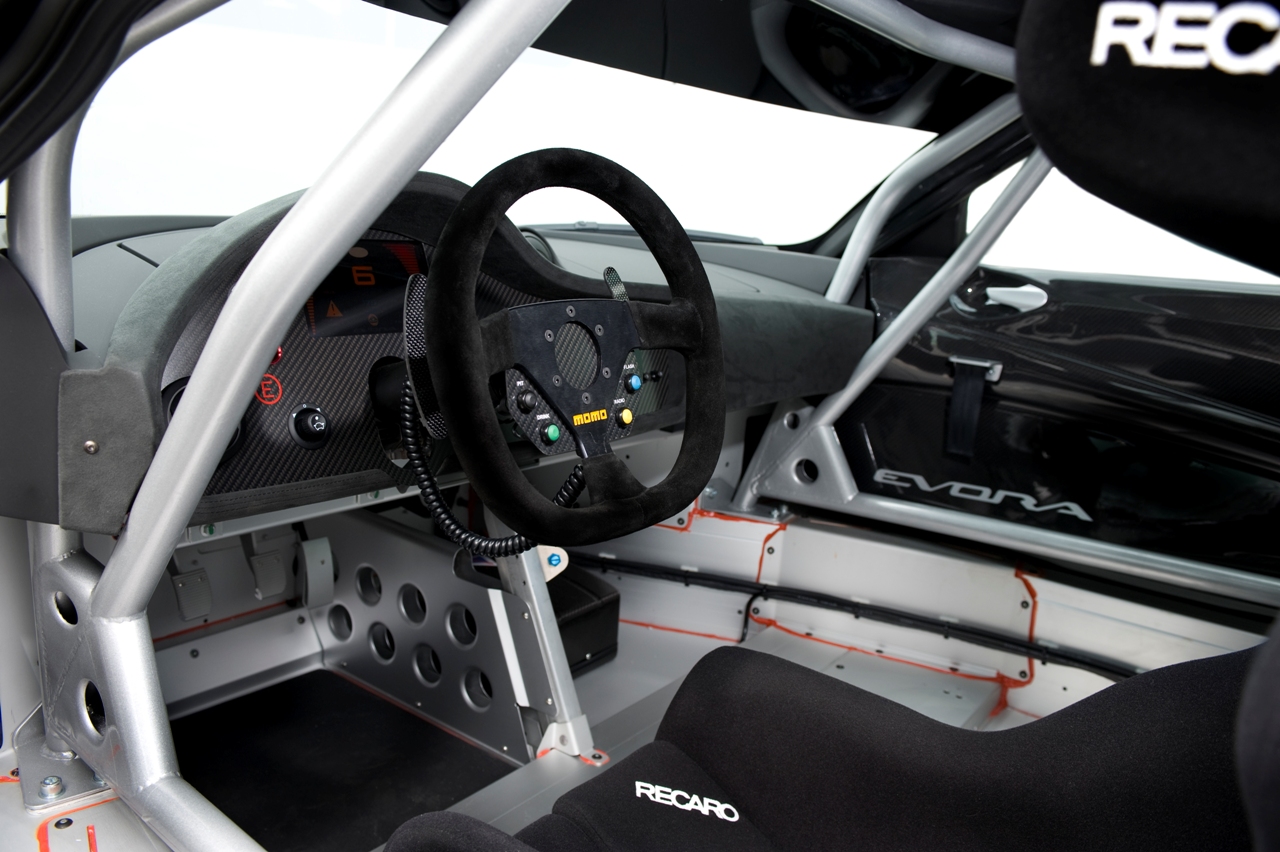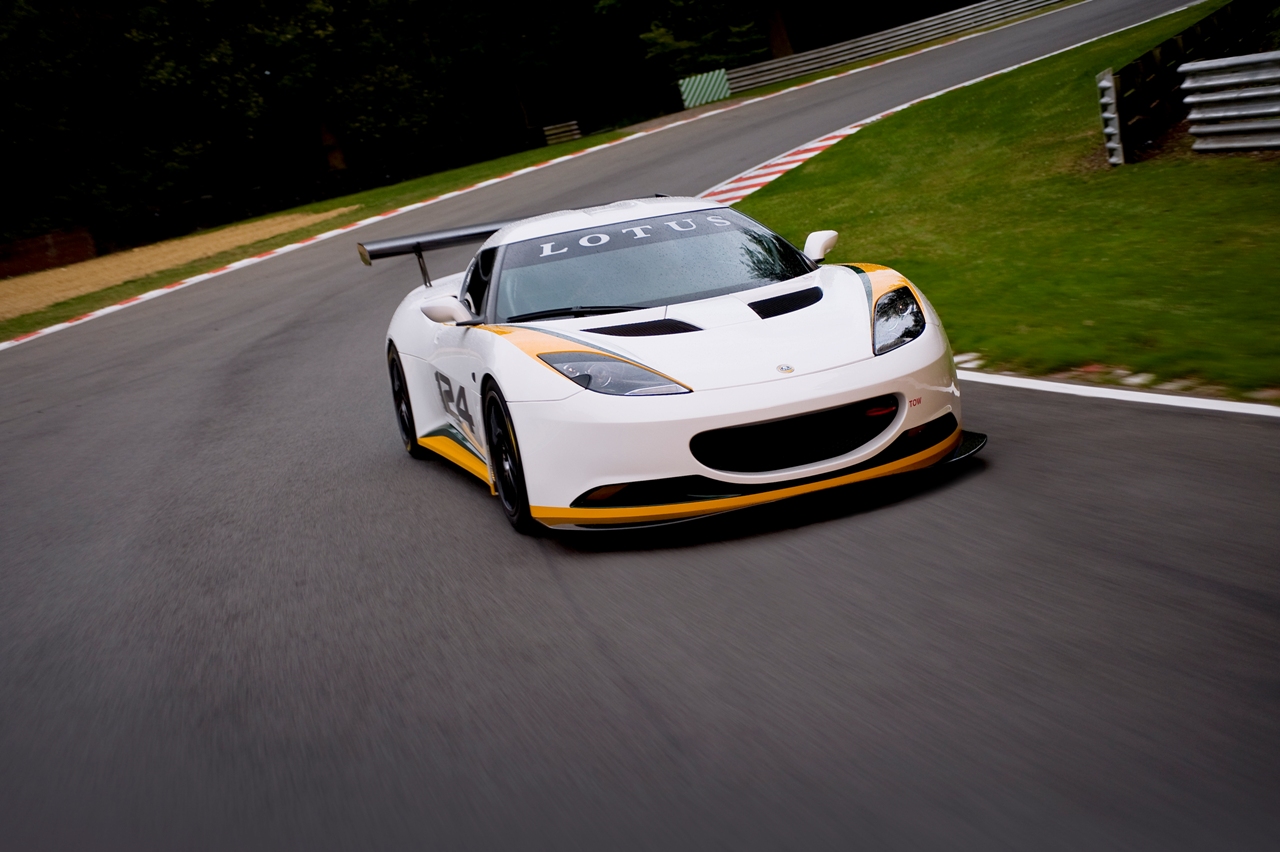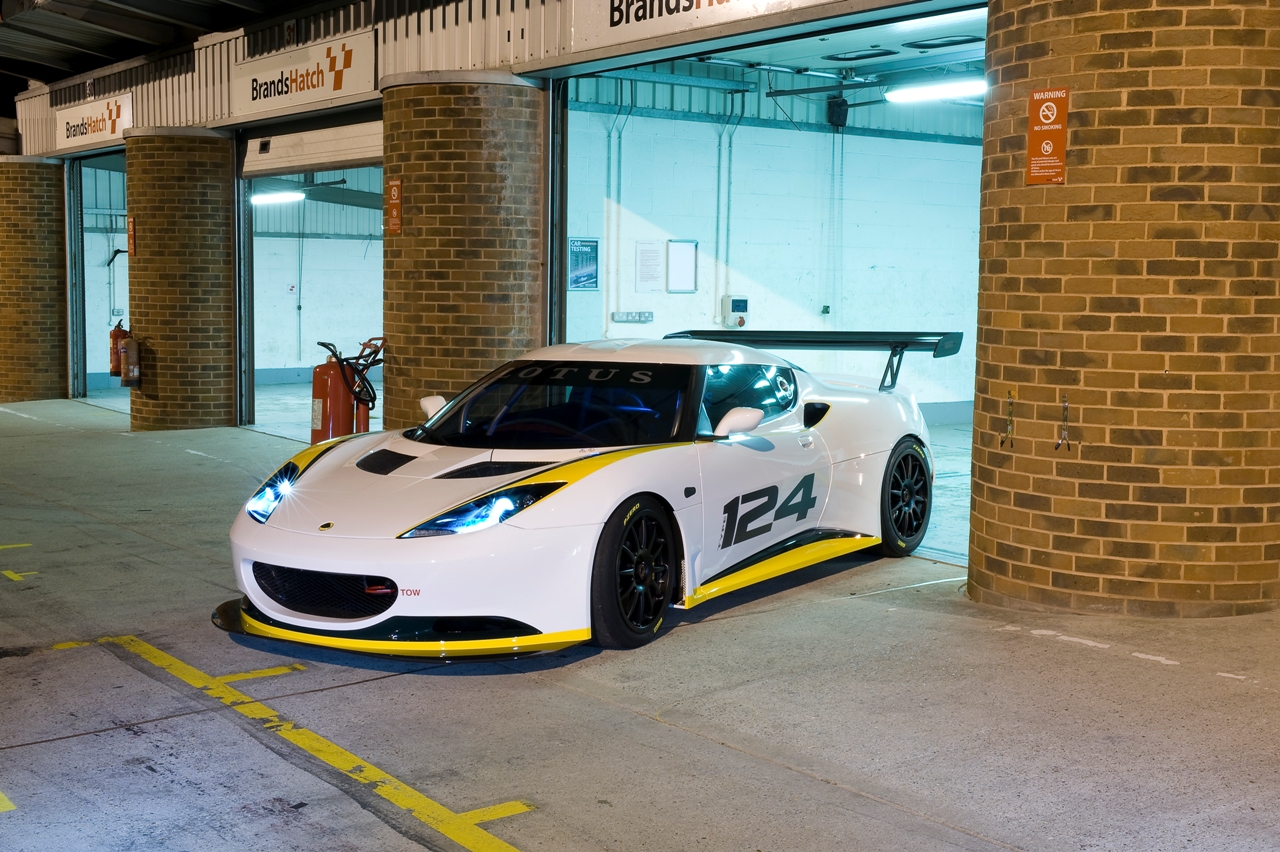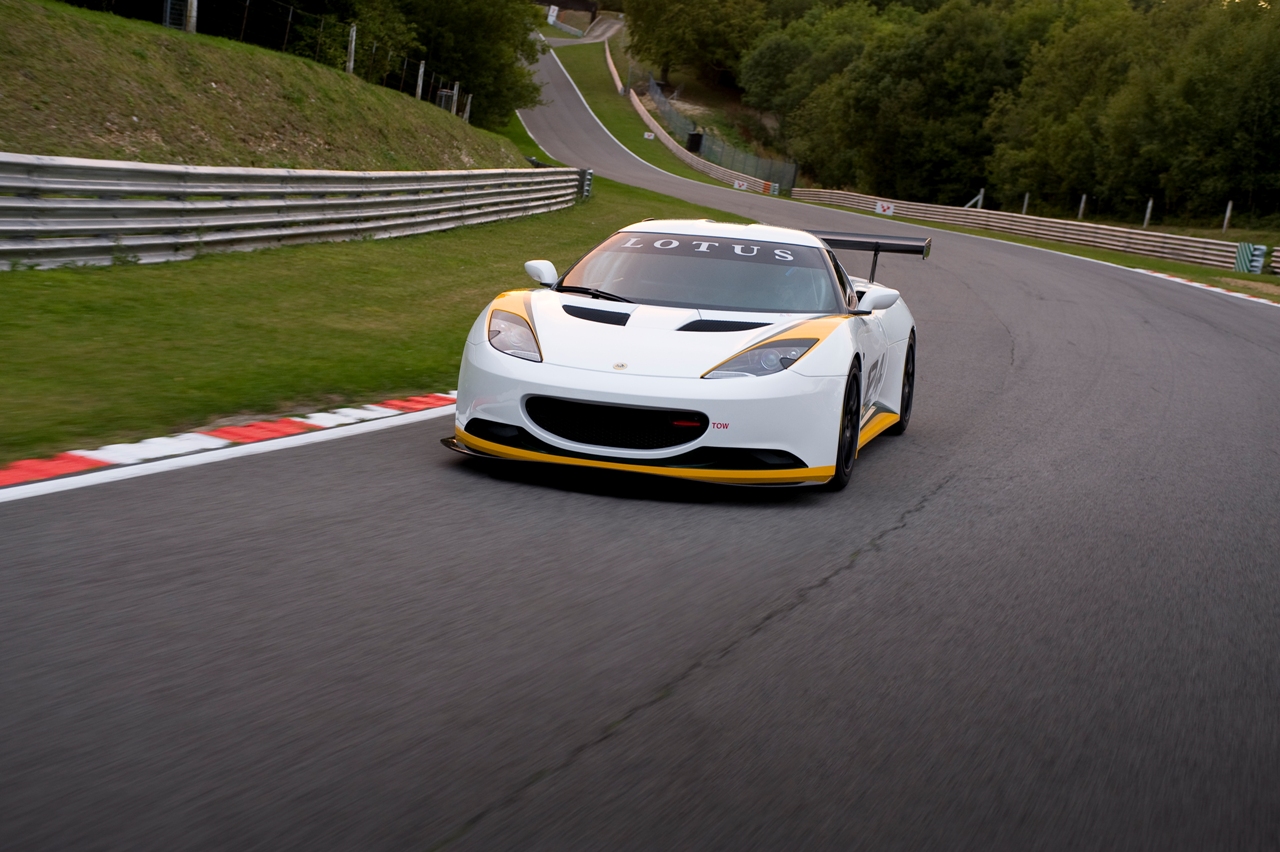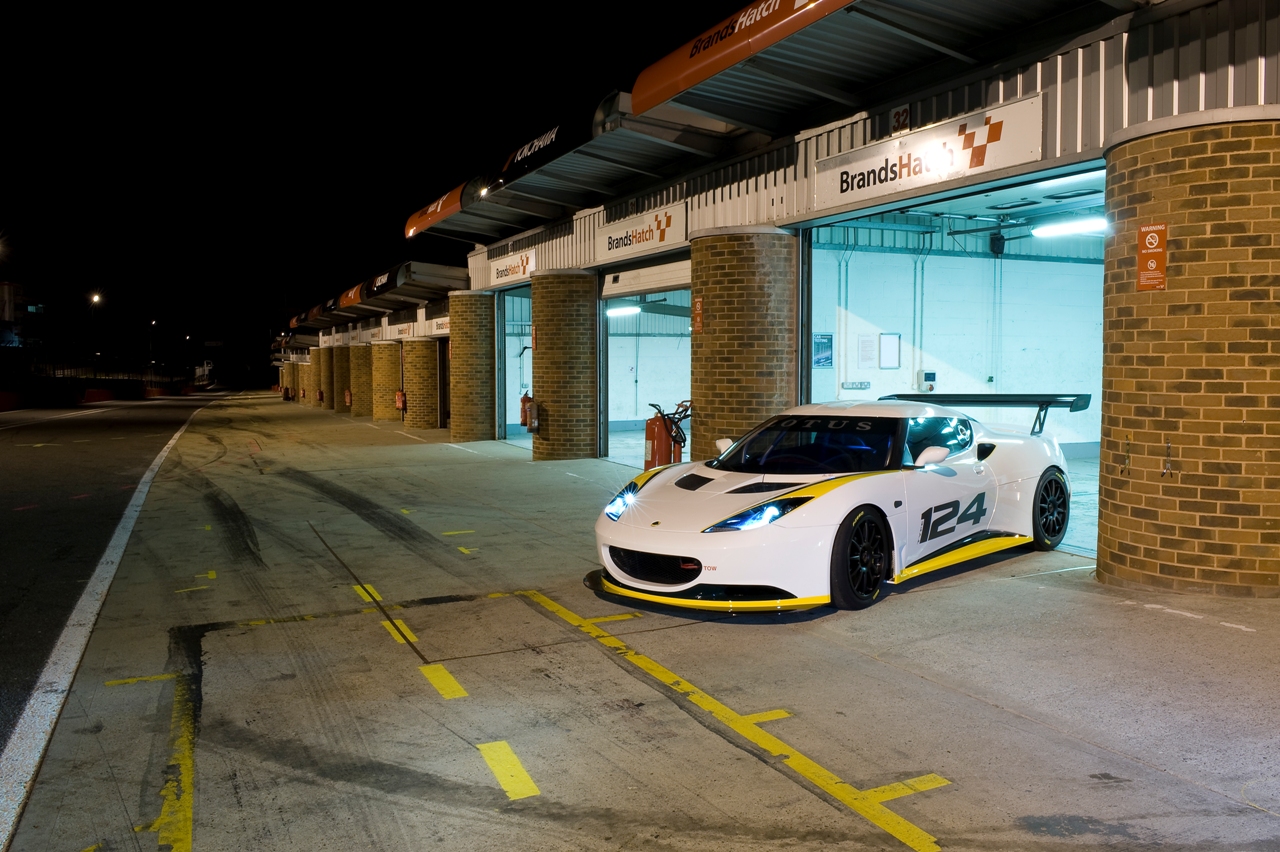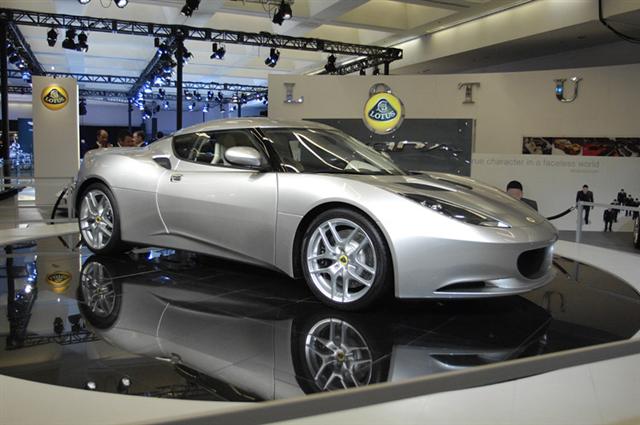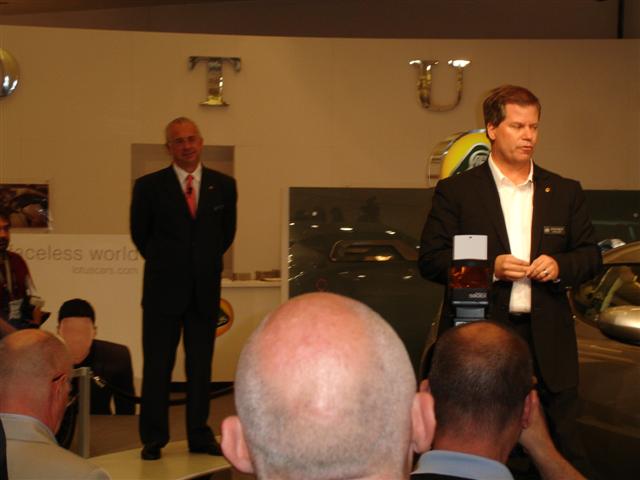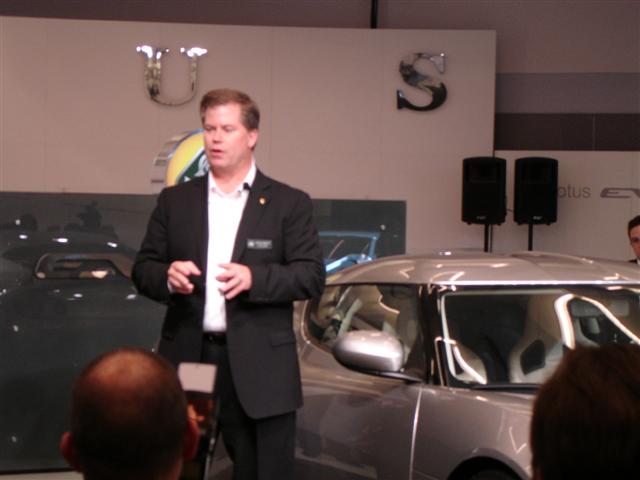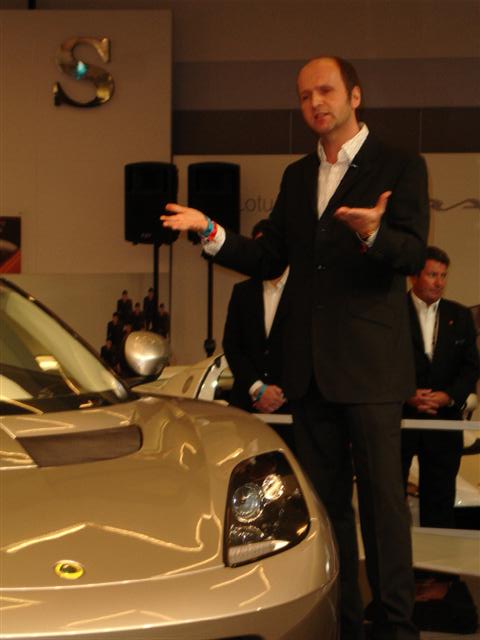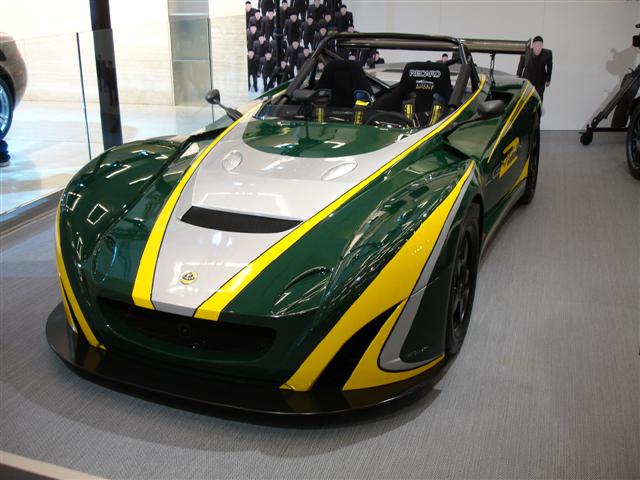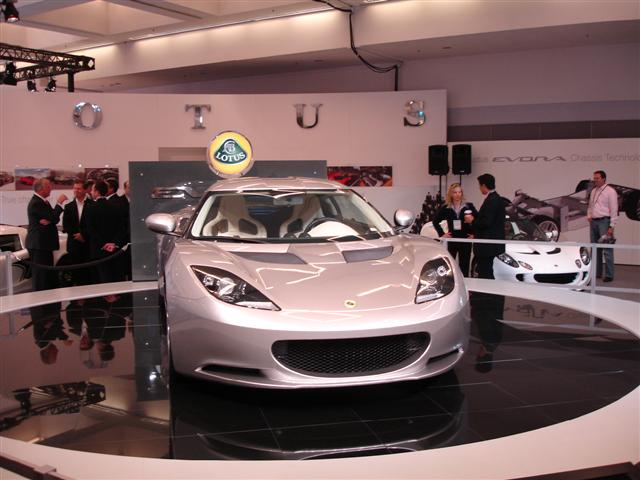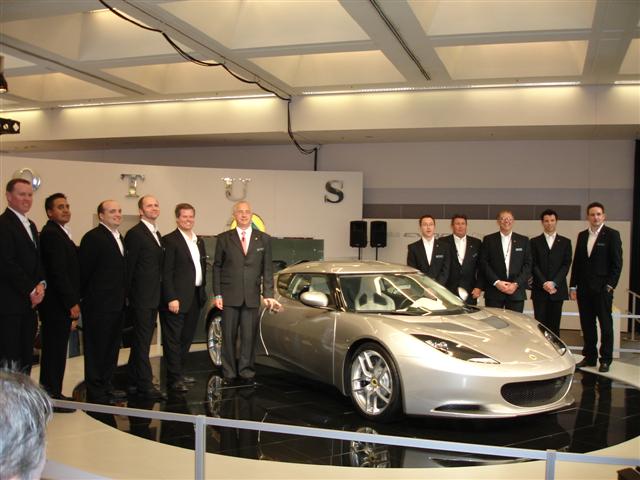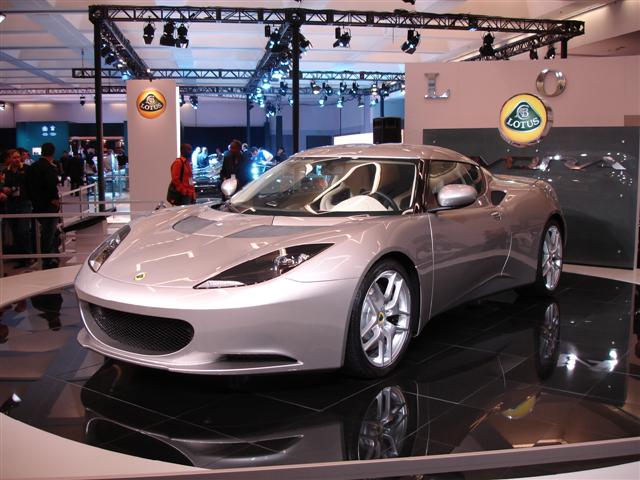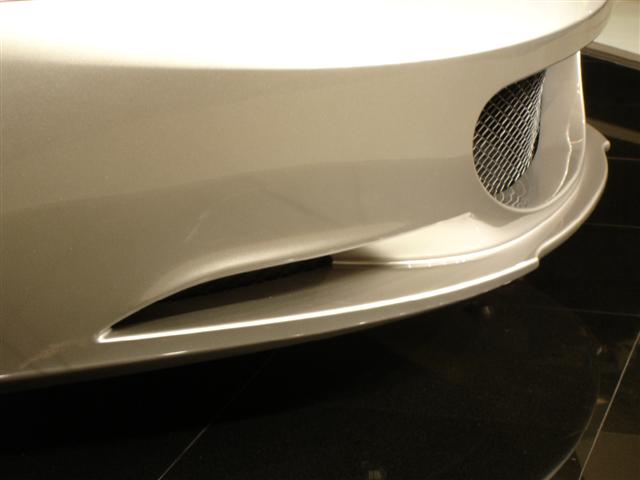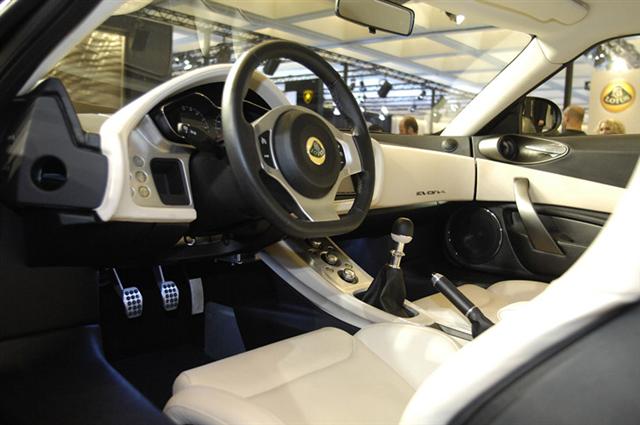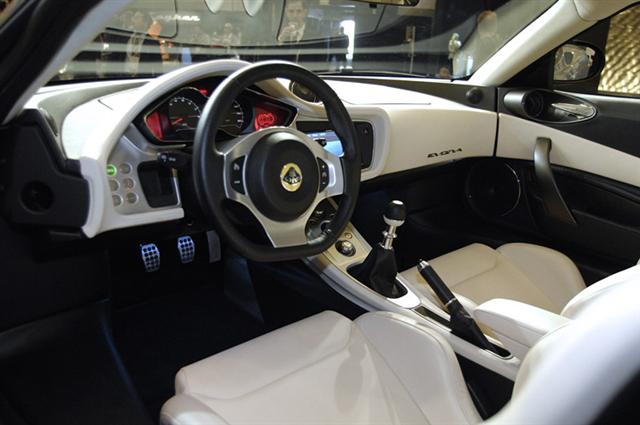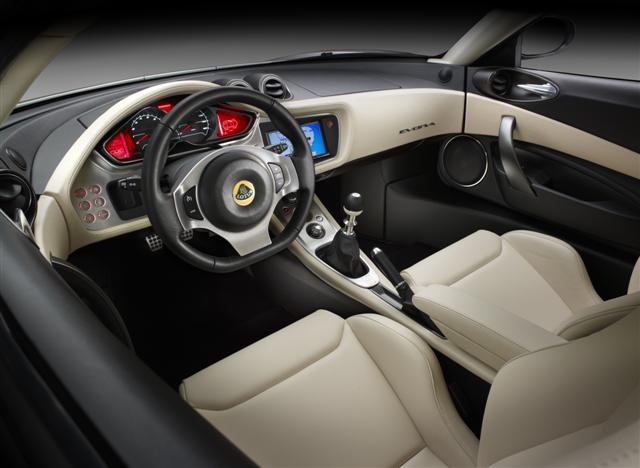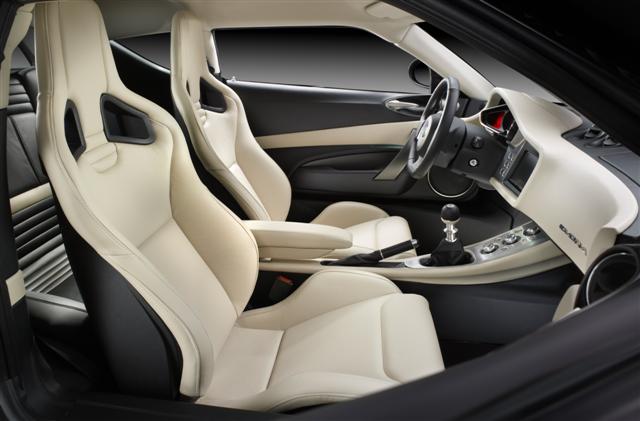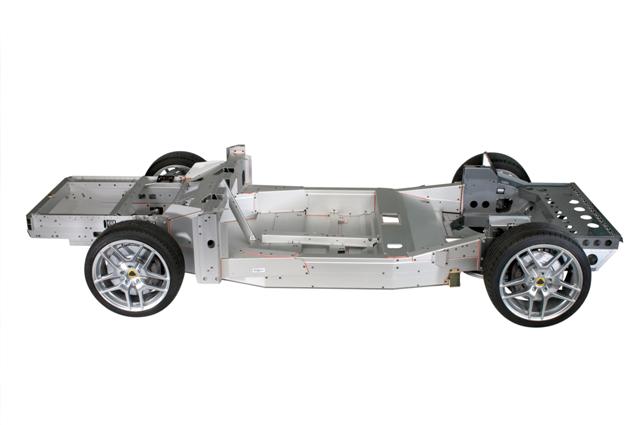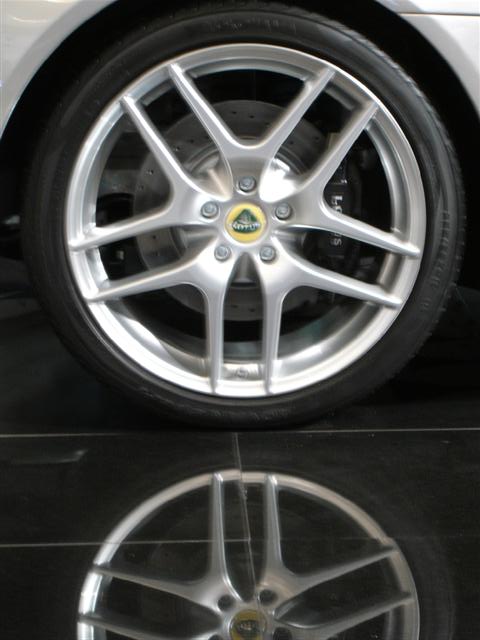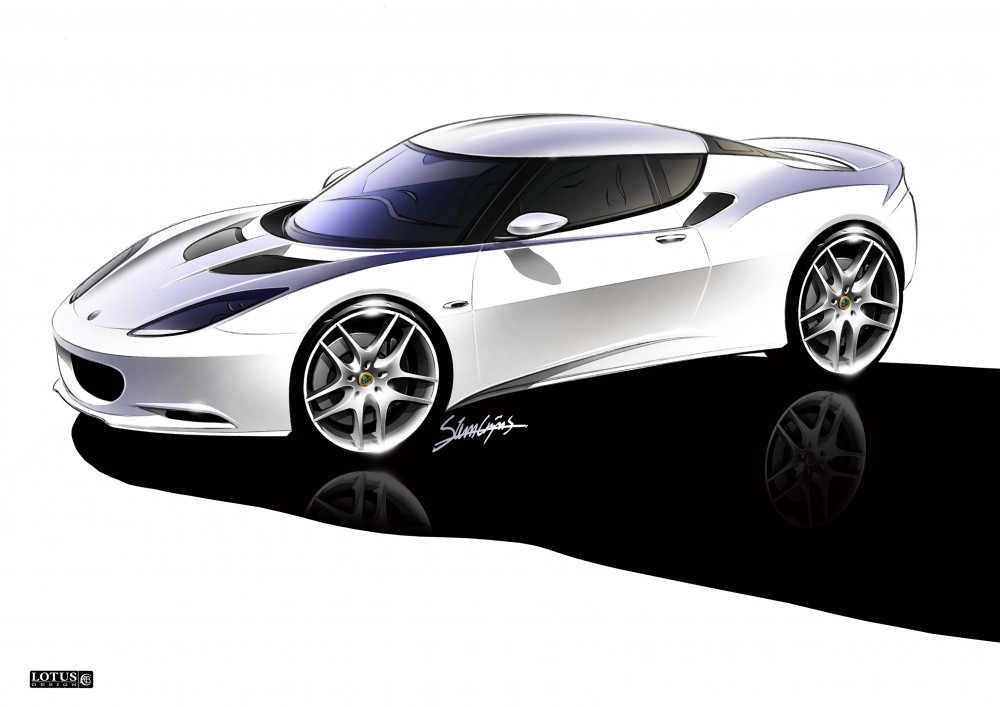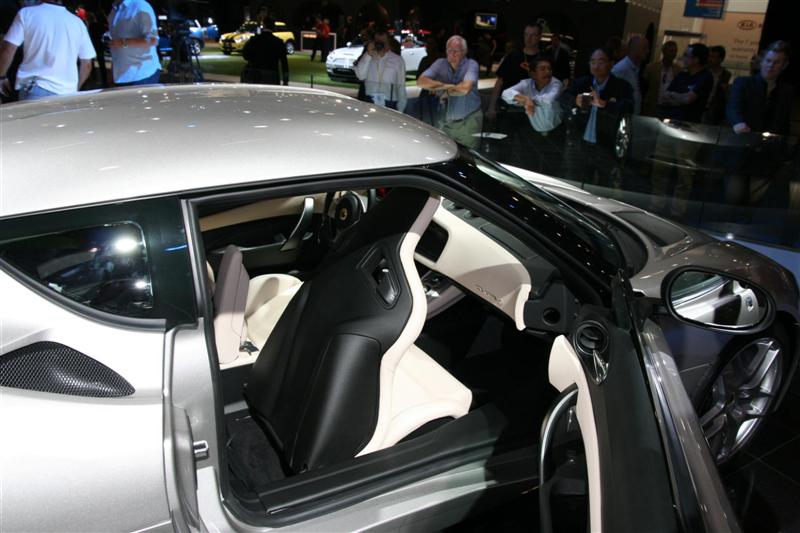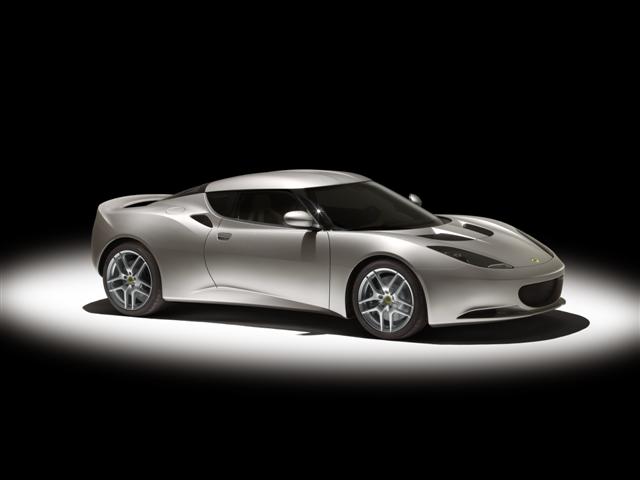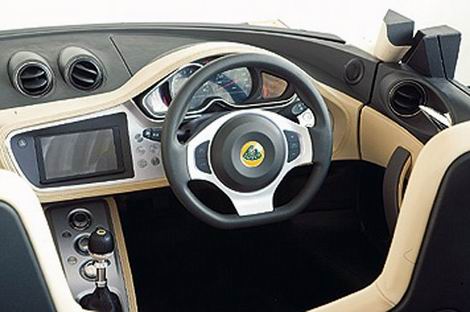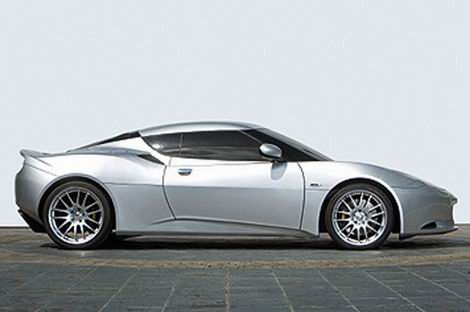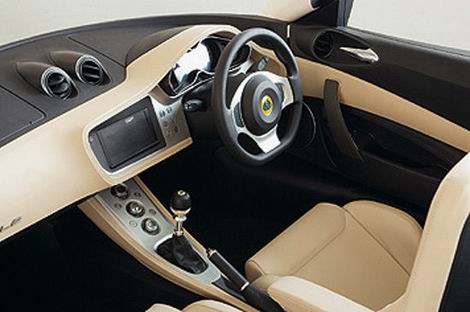Lotus Evora GTE Road Car!
Date: August 17, 2011
The Lotus Evora GTE Road Car Concept was premiered at the Monterey - Pebble Beach weekend.
The new Lotus Evora GTE Road Car Concept was unveiled to the world for the first time within the Lotus exhibit at the McCall’s Motorworks Revival event, August 17, 2011 at the Monterey Jet Center. The Concept car was then moved to the Lotus exhibit at the Lodge at Pebble Beach where the GGLC caught the car.
The Lotus Evora GTE is a race car developed with a single-minded aim to be successful in the new global motorsport GTE category, which includes the world famous Le Mans 24 Hours. Now, Lotus has taken this and developed a race-inspired Evora GTE Road Car Concept. This high-strung Evora elicits over 420 bhp from its race-developed engine, fed through a sequential AMT racing gearbox and put to the pavement through ultra-lightweight forged alloy wheels with center-lock hubs shod with Pirelli P-Zero Corsa tires.
The Evora GTE Road Car Concept body is fashioned of carbon fiber with bodywork straight off the Evora GTE race car.
Lotus Evora Type 124 Endurance Racecar!
Date: Sept 11, 2009
The Lotus Evora Type 124 Endurance Racecar has been developed from the award-winning Evora road car and is built to FIA regulations and safety standards.
The Type 124 (pronounced One Twenty Four) Endurance Racecar is the next step in the evolution of the Evora. The car will make its 24 hour racing debut at the ADAC Nürburgring 24 Hours which provides a great test for the Evora’s performance, efficiency and durability under tough and demanding endurance race conditions.
At the heart of the Lotus Evora are fundamental racecar elements: mid-engine layout, high-tech and super-stiff extruded and bonded aluminium chassis and very strong lightweight forged aluminium wishbones. All these elements mean that it is a natural evolution from the road going Lotus Evora to a competitive endurance racecar.
From the outset the design team had intentions to take the Evora racing and the chassis was designed with this in mind. Endurance races are the perfect events to showcase the efficiency, handling and durability characteristics that have been fundamental to the concept of the Evora.
The Lotus Evora Type 124 Endurance Racecar has a race-tuned version of the mid-mounted Toyota V6 engine, with power increased to over 400 ps (depending on race regulations). Vehicle mass is expected to be reduced by up to 200 kg, bringing the weight of the racecar to less than 1200 kg (depending on race regulations).
Further changes for the Lotus Evora Type 124 Endurance Racecar include a six speed sequential paddle shift racing gearbox, full FIA specification roll cage, FIA-compliant 120 litre ATL fuel system, FIA fire extinguisher system, competition carbon fibre rear wing, diffuser and front splitter.
The racecar is fitted with AP Racing 6 piston callipers front and rear, with a race-tuned Bosch ABS system, 4-way adjustable dampers and adjustable anti-roll bars. The racecar runs on 18” rims shod with Pirelli racing slicks and the wheels widths have been increased over the roadcar to 9 ½ J on the front and 11 J on the rear.
The aerodynamically efficient Lotus Evora Type 124 Endurance Racecar body design, made from lightweight composite and carbon fibre panels, remains predominantly unchanged from the road car, with the only modifications being to the lower sections of the front and rear clamshells and the side sills.
Luke Bennett, Director of Lotus Cars Limited, said, “Motorsport has been in our blood ever since our founder, Colin Chapman, built the first Lotus back in 1948. We are proud of our motorsport history, which includes victories in Formula One, Le Mans, saloon car, rally car and sportscar racing around the world; more recently, we won the British GT3 Championship in 2006 with the Lotus Exige. The Lotus Evora Type 124 Endurance Racecar is from the same unique stable and we expect it to be a competitive racecar when we enter various endurance races next year.”
Roger Becker, Vehicle Engineering Director for Group Lotus Plc said, “Every Lotus car is designed to be at home on the race track as well as the road, and the Evora is no different. Designed primarily as an everyday road car, the Evora’s lightweight and stiff structure, its aerodynamics and performance means that it is perfectly suited to taming race tracks around the world, and we are looking forward to seeing the new Lotus Evora Type 124 Endurance Racecar line up on the grid for the 2010 season.”
The racecar is expected to compete in a number of endurance races in 2010/ 2011 forming part of a factory-supported race program. The races that are targeted are: The 2010 ADAC Nürburgring 24 Hours (Nürburgring Nordschleife, Germany) in May 2010, Merdeka Millennium 12 Hours (Sepang, Malaysia) in August 2010, BritCar 24 Hours (Silverstone, UK) in October 2010 and the Dubai 24 Hours (Dubai Autodrome, UAE) January 2011.
The FIRST Evora is Delivered!
Date: Sept 1, 2009
Matthew Melling of Twickenham, UK received the keys of a Storm Titanium Lotus Evora from Luke Bennett, Director of Lotus Cars Limited at the Lotus Headquarters where the new mid-engined 2+2 sportscar is hand built.
Many Lotus dealers around the world have already received their demonstrators and Lotus has, so far, received orders for the next 5 months of production. Demand for Lotus’ award winning Evora has meant that 150 extra new manufacturing staff have been recruited to support assembly operations in Norfolk, UK, a very positive sign at a time when the global motor industry faces huge challenges. Full production is expected to reach the maximum rate by the end of November 2009.
Luke Bennett, Director of Lotus Cars Limited said, “It is quite an emotional time to deliver the first Lotus Evora to Mr. Melling. The whole team has worked incredibly hard to design, engineer and produce such a stunning and high performing sportscar and it is a great feeling to hand over the keys to the first customer today. The Evora has won many awards around the world already so we are not surprised that there is high demand for the car and I am sure that each customer who receives their car will be delighted with their purchase.”

Luke Bennett, Director of Lotus Cars (left) hands over the keys of the first customer Lotus Evora to Mr Matthew Melling at the Lotus Headquarters in Norfolk, UK.
Matthew Melling, a customer of Stratton Motor Company, in Norfolk said, “I was determined to be the first in the world to get my hands on an Evora so with Stratton Motor Company’s help, I laid down my deposit within seconds of the order books being opened last year. I have read all the press reviews of the Evora and am so excited about getting behind the wheel – what a great start to September!”
Evora UK options and pricing
Date: March 2, 2009
| Evora 2+0 | £ 47,500 |
| Evora 2+2 | £ 49,875 |
| Tech Pack | £ 2,495 |
| Sport Pack | £ 950 |
| Premium Pack | £ 2,495 |
| Metallic Paint | £ 538 |
| Lifestyle Paint | £ 979 |
| Premium Paint | £ 1,957 |
| Powerfold Door Mirrors | £ 300 |
| Bi-Xenon Headlamps | £ 550 |
| Alpine/Lotus IMPRINT Sound | £ 1,495 |
| Alpine Reversing camera | £ 300 |
| Stealth Grey cast alloy wheels | £ 300 |
| Silver forged alloy wheels | £ 1,495 |
| Gloss Anthracite forged alloy wheels | £ 1,795 |
| Sports ratio 6-speed manual transmission | £ 1,495 |
First deliveries of the eagerly anticipated Lotus Evora will be made to customers in Europe in May 2009 following an extensive and rapid development programme, enabling the whole project to be completed in an extraordinary 27 months, almost unprecedented in the motor industry.
The Lotus Evora Launch Edition
The first 450 cars will be built to a high level standard specification which includes the following equipment:
The Launch Edition includes either Ardent Red or British Racing Green as standard, and all other colours from the Lotus range are available as a cost option.
Following on from these first 450 Lotus Evora Launch Edition sportscars, customers will have the opportunity to spec to a more personal level – but of course they will not be part of the select few who will be among the first to own Britain’s latest sportscar and one of the most anticipated cars of the year, complete with a unique Evora commemorative build plate in the cabin.
The Lotus Evora in Summary
The Lotus Evora will enter the sportscar market as the only mid-engined 2+2 in production. The new car is a
more holistic offering than the Elise, Europa and Exige models that have been so massively popular and iconic.
The Lotus Evora is designed for people who desire exotic sportscar characteristics of stunning design, exclusivity,
dramatic proportions and performance. However, it offers real-world usability and a unique sense of occasion.
Powered by a 3.5-litre V6 producing 280 PS and 342 Nm of torque, the new car employs innovative lightweight chassis
technology to ensure all-round dynamic performance, in keeping with the great Lotus tradition.
Straight line performance is spectacular, with the zero to 100 km/h sprint taking place in just over 5 seconds with a top speed of over 260 km/h (prototype figures). Economy and emissions figures are class leading with the Official European Combined Cycle fuel economy being just 8.7 litres / 100 km and the emissions being just 205 g / km CO2. The other fuel economy figures are equally impressive with Official European Urban Cycle figures of 12.4 litres / 100 km and 6.5 litres / 100 km for the Official European Extra Urban Cycle.
Inside, the Lotus Evora cocoons occupants with sumptuous leather surfaces juxtaposed with contemporary high-tech features. With driver focused instrumentation the occupants sit in cockpit-esque surroundings. A beautifully appointed dash boasts tactile details such as flush-mounted controls that glow with blue LED haloes and a stylised speedometer and rev counter ensuring that controls are both attractive and accessible. Styled in-house by Lotus Design, the Evora’s sophisticated and attention-snaring lines brilliantly disguise its ability to accommodate passengers in the rear of the cabin, giving the car the external characteristics of a small, nimble sportscar belying its real exterior and internal space. As well as being sold in a 2+2 configuration, the car will also be available as a two-seater, the space in the rear being allocated to luggage storage. Other derivatives are also planned for the long term future, including a convertible and a version with automatic transmission.
The first production Lotus Evoras have already started down the assembly line at Lotus’ high tech manufacturing facilities in Worcester UK (where the advanced extruded and bonded aluminium chassis is made) and at the Lotus Headquarters in Hethel UK. Build volumes are expected to ramp up steadily over the next few months with a target of 34 Lotus Evoras being made each week by July 2009. This manufacturing volume is in addition to the current build volume for Lotus small car platform vehicles (Elise, Exige, Europa and 2-Eleven) of 44 per week building to 55-60 per week in the run up to the northern hemisphere summer.
For peace of mind, the Lotus Evora has a 3 year 100,000 km (60,000 miles) whole vehicle warranty with an 8 years chassis perforation warranty for EU markets.
Full standard equipment, together with the Manufacturer’s Suggested Retail Prices for the Lotus Evora and the cost option equipment are listed below:
Lotus Evora Standard and Cost Option Equipment
| S=Standard O=Cost option |
||
| Engine and transmission | ||
| 206 kW (276 hp, 280 PS) 3.5 litre V6 engine with VVT-I | S | |
| 6-speed manual transmission | S | |
| Sports ratio 6-speed manual transmission | O | |
| Optimal gear shift-point display | S | |
| Twin polished exhaust tailpipe | S | |
|
Handling technology |
||
| Fully independent suspension layout | S | |
| Forged aluminium unequal length double wishbones with integral joint | S | |
| Bilstein mono-tube gas dampers (front and rear) | S | |
| Eibach coaxial coil springs (front and rear) | S | |
| Anti-roll bars (front and rear) | S | |
| Yokohama Advan Sport LTS tyres (225/40 ZR18 front and 255/35 ZR19 rear) | S | |
| Hydraulically-assisted power steering | S | |
| BOSCH Electronic Differential Lock (EDL) | S | |
| Switchable traction control | S | |
|
Safety |
||
| Lotus lightweight deformable bonded front structure | S | |
| Lotus all-aluminium safety monocoque 'tub' | S | |
| Lotus welded galvanised deformable rear structure | S | |
| Lotus side impact safety structure | S | |
| Stainless steel fuel tank, sheltered within safety shell | S | |
| 2-stage airbags for driver and front passenger | S | |
| Isofix child seat fastening system in the rear | S on 2+2 seating configuration only | |
| AP racing 4-piston fixed aluminium alloy 2-piece callipers | S | |
| Ventilated brake discs (350 mm front and 332 mm rear) | S | |
| BOSCH ABS with servo assisted brakes featuringHydraulic Brake Assist (HBA) Electronic Brake Distribution (EBD) | S | |
| Key located remote control central locking system and boot release | S | |
| Immobiliser and key activated alarm | S | |
| 3rd brake light – high mounted | S | |
| Rear windscreen demister | S | |
| Insulated double glazed rear window, filled with Argon | S | |
Wheels |
||
| Silver cast alloy wheels (18" front and 19" rear) | S | |
| Silver forged alloy wheels (18" front and 19" rear) | O | |
| Stealth Grey cast alloy wheels (18" front and 19" rear) | O | |
| Gloss Anthracite forged alloy wheels (18" front and 19" rear) | O | |
Exterior equipment |
||
| Halogen headlights | S | |
| Bi-Xenon headlights, incl. headlight washing system | O | |
| Solar glass windscreen | S | |
| Body coloured, heated, electric door mirrors | S | |
| Body coloured, heated, electric, power-fold door mirrors | O | |
| Aerodynamically optimised rear diffuser and wing | S | |
| Body coloured door handles | O | |
| Chrome brand and model designation badges | S | |
Interior specification |
||
| Air conditioning unit | S | |
| Adjustable Recaro Black leather sports seats (front). Recline tilt and slide | S | |
| Flat-bottomed leather/magnesium steering wheel | S | |
| Manual steering column adjustment for length and height | S | |
| Bespoke aluminium illuminated control knobs and switches | S | |
| Electric windows | S | |
| Leather gear-knob | S | |
| Leather handbrake sleeve | S | |
| Remote release glove box | S | |
| Door storage bins & integrated cup holders | S | |
| 12-V interior accessory socket | S | |
| 12-V boot mounted battery accessory socket | S | |
| Lotus command centre with auxiliary trip computer | S | |
Entertainment |
||
| Alpine CD/MP3/WMA receiver including: | S | |
| 2x45W High Power Amp (6" 1/4 coaxial 2-way speakers & dash mounted tweaters) | S | |
| CD-R/-RW/MP3 Playback | S | |
| Full speed connection for iPod touch, iPod nano and all iPod models with dock connector | S | |
| Full speed AUX input | S | |
| Quick search | S | |
| Lightweight fractal aerial | S | |
| Tech pack | O | |
|
|
||
| Tech pack upgrades: | ||
| Alpine/Lotus IMPRINT Sound with Specialised Advanced fine tuning. Optimisation of sound reproduction Enhanced sound staging and definition within the car | O | |
| Alpine Reversing camera (day & night) with 138 degree Field of View | O | |
| Premium pack: | O | |
|
|
||
| Sport pack: | O | |
|
|
||
Paints |
||
Solid Paint |
S | |
|
|
||
| Metallic Paint
Starlight Black Liquid Blue Persian Blue Canyon Red Arctic Silver Storm Titanium Solar Yellow |
O | |
| Lifestyle Paint
Laser Blue Isotope Green Carbon Grey Graphite Grey Chrome Orange Quartz Silver Aspen White Saffron Yellow |
O | |
Premium Paint Burnt Orange Ice White |
O | |
| Warranty EU Markets | 3 year 100,000 km (60,000 miles) whole vehicle warranty. 8 years chassis perforation warranty. Customers statutory rights not affected. | |
Pricing
MSRP shown, includes local taxes and transport
France |
Italy |
Belgium |
Switzerland |
|
| Evora 2+0 | € 61.189,-- | € 61.874,-- | € 61,809.-- | CHF 93,241.-- |
| Evora 2+2 | € 64.717,-- | € 65.413,-- | € 65,378.-- | CHF 97,829.-- |
| Tech Pack | € 3.508,-- | € 3.519,-- | € 3.549,-- | CHF 5.228,-- |
| Sport Pack | € 1.498,-- | € 1.503,-- | € 1.515,-- | CHF 2.233,-- |
| Premium Pack | € 3.005,-- | € 3.015,-- | € 3.040,-- | CHF 4.478,-- |
| Metallic Paint | € 995,-- | € 998,-- | € 1.007,-- | CHF 1.482,-- |
| Lifestyle Paint | € 1.859,-- | € 1.866,-- | € 1.881,-- | CHF 2.771,-- |
| Premium Paint | € 2.751,-- | € 2.760,-- | € 2.783,-- | CHF 4.101,-- |
| Powerfold Door Mirrors | € 291,-- | € 292,-- | € 295,-- | CHF 433,-- |
| Bi-Xenon Headlamps | € 995,-- | € 998,-- | € 1.007,-- | CHF 1.484,-- |
| Alpine/Lotus IMPRINT Sound | € 1.498,-- | € 1.503,-- | € 1.515,-- | CHF 2.234,-- |
| Alpine Reversing camera | € 593,-- | € 595,-- | € 600,-- | CHF 892,-- |
| Stealth Grey cast alloy wheels | € 553,-- | € 555,-- | € 559,-- | CHF 825,-- |
| Silver forged alloy wheels | € 2.000,-- | € 2.007,-- | € 2.023,-- | CHF 2.985,-- |
| Gloss Anthracite forged alloy wheels | € 2.764,-- | € 2.773,-- | € 2.796,-- | CHF 4.122,-- |
| Sports ratio 6-speed manual transmission | € 1.809,-- | € 1.815,-- | € 1.830,-- | CHF 2.698,-- |
| MSRP : | MSRP: | |||
| including local tax | excluding local tax | |||
| excluding transport | excluding transport | |||
Germany |
United Kingdom* |
Euro zone Countries |
||
| Evora 2+0 | € 59.990,-- | £ 47,500.-- | € 50.412,-- | |
| Evora 2+2 | € 63.500,-- | £ 49,875.-- | € 53.361,-- | |
| Tech Pack | € 3.490,-- | £ 2,495.-- | € 2.933,-- | |
| Sport Pack | € 1.490,-- | £ 950.-- | € 1.252,-- | |
| Premium Pack | € 2.990,-- | £ 2,495.-- | € 2.513,-- | |
| Metallic Paint | € 990,-- | £ 538.-- | € 832,-- | |
| Lifestyle Paint | € 1.850,-- | £ 979.-- | € 1.555,-- | |
| Premium Paint | € 2.737,-- | £ 1,957.-- | € 2.300,-- | |
| Powerfold Door Mirrors | € 290,-- | £ 300.-- | € 244,-- | |
| Bi-Xenon Headlamps | € 990,-- | £ 550.-- | € 832,-- | |
| Alpine/Lotus IMPRINT Sound | € 1.490,-- | £ 1,495.-- | € 1.252,-- | |
| Alpine Reversing camera | € 590,-- | £ 300.-- | € 496,--; | |
| Stealth Grey cast alloy wheels | € 550,-- | £ 300.-- | € 462,-- | |
| Silver forged alloy wheels | € 1.990,-- | £ 1,495.-- | € 1.672,-- | |
| Gloss Anthracite forged alloy wheels | € 2.750,-- | £ 1,795.-- | € 2.311,-- | |
| Sports ratio 6-speed manual transmission | € 1.800,-- | £ 1,495.-- | € 1.513,-- | |
All prices include first service and manufacturers warranty
All prices exclude on the road costs; on the road costs typically refer to registration, fuel, license plates, road tax, local dealer charges
UK MRSP price - add £950 for on the road price
Lotus Evora:
Lotus Evora Introduction!
Date: Nov 21, 2008
The Lotus Evora was introduced to the US Press and to consumers at the Los Angeles Auto Show this week.
GGLC Webguy notes & impressions
The Lotus Press Conference was held on Thursday, Nov 20th at the Los Angeles Convention Center. Recent addition to
the Lotus Cars USA (LCU) team, Kevin Smith, PR Manager hosted the event. Standing in front of the Evora surrounded by
over 100 members of the press.
Evora - What's it origin?
Evora, it follows the long tradition at Lotus to start the names of the cars with "E", but Roger Becker, explained
that there was more to the name. "E" stands for Evolution, since Lotus has been evolving for 60 years! "VO" stands for
Vogue, because the Evora brings the cutting edge in technology and driving. "RA" is for the feeling of the "Special
Presence" that the Evora evokes.
Technical Highlights
Here are few technical highlights gleaned from Roger's presensation.
Evora Trivia... The Evora is only the 4th mid-engine 2+2 ever produced, can you name the other three?
Cheers,
GGLC WebGuy signing off from LAX
LOTUS EVORA NORTH AMERICAN DEBUT (press release)
With its stunning visual impact, exhilarating overall dynamic performance, innovative chassis technology and high levels of luxury, packaging and convenience, the Evora makes its North American debut at the Los Angeles Auto Show.
Los Angeles, CA - The first all-new Lotus since the iconic Elise made its debut in 1995, the Evora enters the sports car market as the world's only mid-engine 2+2. Powered by a Lotus-tuned 3.5-liter V6 engine producing 276 hp, and weighing just 2,976 lbs. (prototype specification), the Evora promises breathtaking performance. During preliminary testing around the famous Nürburgring, the Lotus chassis development engineers report Evora is extremely agile and great fun to drive - even when clad with the full development disguise that hid the beautiful lines from the prying motor industry paparazzi.
In addition to its excellent performance and exemplary handling, the Evora offers a more refined ownership experience than Lotus's existing smaller four-cylinder models. Evora's contemporary cabin is elegantly trimmed and its equipment list includes such high-tech features as an advanced touch-screen multi-media system incorporating a state-of-the-art Alpine satellite navigation and audio system. Because one of the roles of the Evora is to attract new customers to the Lotus brand, much attention has been paid to its ease of use. Wider, taller door apertures and narrower sills make getting in and out of the cabin a less athletic undertaking than it is in Lotus's smaller sports cars (the Elise, Exige and 2- Eleven), while the design of the cabin itself will accommodate two 99th percentile (6ft 5in tall) American males in the front seats.
The 'convenience factor' of the Evora extends to less obvious areas of the car. For instance, beneath the skin the entire front-end structure is a high tech aluminium sacrificial modular sub-frame unit, attached to the main extruded aluminium tub. This modular unit is designed to deform for maximum safety, and to reduce repair costs in the event of a frontal impact.
The Evora has been designed with global automotive regulations in mind, and in preparation for future variants that are planned including a convertible. The Evora will be hand- crafted and built on a dedicated new assembly line within Lotus's advanced manufacturing facility at Hethel in the east of England. Capacity limitations will restrict production to approximately 2,000 cars a year, ensuring the dynamic new sports car's rarity and exclusivity.
Mike Kimberley, CEO of Group Lotus plc, has this to say about the exciting new model: "The Evora is the biggest milestone Lotus has achieved since the Elise was born 13 years ago and is part of our bold five-year strategic plan, which includes the introduction of new cars and technologies to many more markets around the world. The Evora also represents Lotus core values of performance through light weight and efficiency and proves that you can have phenomenal performance, fuel-efficiency elegant design and practicality all in a class leading mid-engine 2+2 sports car, which will meet global safety and homologation standards."
Mike Kimberley continues, "Looking to the future, we will continue to research, develop and produce lighter, more efficient vehicles which are linked to our extensive work on all aspects of future fuels, alternative engines and electric and hybrid vehicle propulsion systems. We all have an environmental responsibility to future generations and the Evora is our latest proof that Lotus' value of "performance through light weight" improves the efficiency and sustainability of the automobile."
THE EVORA IN DETAIL
Style or function? Have both…
Designed 'in-house' by Lotus Design, the sleek and athletic shape uses fluid forms and crisp surfaces to communicate velocity, agility and sophistication. Low and wide with
modern cab forward proportions, muscular rear haunches and function-optimized side air intakes; this is clearly a serious mid-engine sports car that skilfully hides the
practicality of its two-plus-two capability.
Russell Carr, Head of Lotus Design, led the Evora design team with Steven Crijns, Design Manager responsible for the exterior and Anthony Bushell, Senior Designer, responsible for the interior.
"A cornerstone of the design's success was working closely with the technical team to develop a package that allowed us to get the proportions correct," says Head of Design Russell Carr, "The asymmetric wheel sizes, the short rear overhang, long front overhang and cab forward visor screen all contribute to giving the car visual movement and an agile stance. This is incredibly important to us because we want the car's aesthetics to communicate its driving characteristics."
Lotus products have always embodied a perfect balance between form and function and the Evora successfully continues this heritage. "We never lost sight of the fact that, although this car must provide real world usability, sports cars are emotional purchases and you have to seduce the customer through beguiling looks and exotic persona. We are, therefore, very proud that we have been able to use technical needs and user functionality to positively drive the design in key areas and create some of the car's most distinctive features," says Carr. "Ingress and egress, for example, dictated a minimal "step-over" to get into the Evora. We simply cut away the surface under the door and created a unique and dramatic piece of sculpture that enhances the stance of the car as well as its usability."
Elsewhere, aerodynamic considerations for drag, downforce and cooling had significant but positive influence on the overall form and details such as air intakes. A desire to create balanced downforce, that increases cornering performance, led to the adoption of the now Lotus "signature" top exit radiator vent, race car inspired diffuser and "floating rear wing". Drag limitation, drove the dramatic tear-dropped cabin layout and the curvaceous plan view has given the car a more muscular rear shoulder that conveys a level of sophistication appropriate to this market segment. "We believe that our designs should be honest as well as dramatic and so we are really pleased with the fact that these iconic features all do a real job" says Steven Crijns, Design Manager.
This inherent understanding of the relationship between the technical and the aesthetic paid dividends the first time a full-scale model of the Evora was wind tunnel tested - only minimal adjustments were required to the car's aerodynamic package to meet the targets for downforce and stability. Steve Crijns continued, "Overall the design language shows a clear DNA link with its Lotus siblings, while also establishing its own distinctive and contemporary theme. The undulating shoulder line is brilliantly mirrored in the lower part of the body side by the cutaway sill that creates a torso-like muscularity."
"The front three-quarter view is really powerful" Russell Carr continues, "Your eye is drawn effortlessly, from our signature mouth, rearward by fluid surfaces and fast lines that create a sense of speed even when the car is stationary. From this angle you can also see how dramatically the visor screen sweeps around the teardrop form of the cabin and the gently tucked plan shape perfectly accentuates the muscularity of the rear fender. This is unmistakeably mid-engine design language and the Evora is unmistakeably a Lotus."
The view from the rear three-quarters is just as striking and the one that many will become familiar with as the car passes them on the road. The tapered cabin, diffuser, floating wing, centrally mounted twin tailpipes and distinctive engine bay vents all combine to create a completely unique look.
Moving right inside…
The design language of the interior reflects that of the exterior - simple, fluid surfaces, soft forms and crisp feature lines wrap around the cabin cosseting the occupants.
Unlike recent Lotus products that use a race car inspired, technical minimalism, the Evora employs a softer approach that utilizes premium quality materials and finishes to
create a contemporary but luxurious ambience that is unique to Lotus products. It is, according to Head of Lotus Design Russell Carr, "A huge departure from what people might
expect based on Lotus's recent past. We wanted the Evora's cabin to feel special and to be surprising as well as sporty. Precision engineered metal inserts and quality edge-lit
switches are brilliantly juxtaposed against soft hand-stitched leather surfaces to give a modern interior with a classic twist."
Russell Carr continues, "The flat bottomed steering wheel, figure hugging sport seats, contemporary instrumentation and ergonomically positioned controls provide an intuitive environment that instantly forms a connection between driver and car ensuring that it becomes an extension of his or her body."
Senior Designer Anthony Bushell explains the choice of materials in the Evora's interior, "Tactile quality is incredibly important within this segment so we wanted the interior to use honest premium materials. Much of the switchgear is bespoke, and every metallic component is actually metal." Focused courtesy lighting is used throughout the interior, giving a spectacular illuminated feel to the sculptured design feature of the cabin. The extensive use of handcrafted, premium leather differentiates The Evora from other Lotus products and is so important to the character of the car that an entire new trim shop has been built at the Lotus Headquarters in the UK, dedicated to its production. Even the entry level versions of the Evora will feature leather-upholstered seats, upper door trim panels and facia, but it is expected that most customers will opt for the full leather interior treatment. With a range of leather colors available, customers will have the opportunity to personalize their Evora.
High-tech treats
Contemporary technology also features in the Evora's cabin. A newly developed Alpine multi-media system with a 7-inch touch-screen provides advanced audio, satellite navigation,
video, Bluetooth® hands-free telephone and iPod® connectivity functions. The screen also serves as a monitor for the Evora's optional reversing camera. The satellite navigation
element of the system is removable, allowing you to program it from the comfort of your home, or take it with you to continue your journey in an unfamiliar pedestrian location.
The Alpine audio set-up is one of the most sophisticated automotive systems in the world. Called IMPRINT and using MultEQ sound enhancement technology, it is able to cancel out sound imbalances caused by the cabin window glass, for instance, creating echoes, while carpets suppress mid-range frequencies - resulting in amazingly crisp, clear, undistorted sound reproduction wherever you are seated in the car. A bespoke air-conditioning system developed by Bergstrom is standard on all models, and has been designed for the hottest climate or highest humidity to help provide maximum occupant comfort. Lotus traction control and onboard tire pressure monitoring will also be available.
One size fits all
The leather clad front seats are very supportive with a lightweight manual adjustment mechanism for fore and aft, rake and lumbar. The rear seats of 2+2 versions of the Evora
are intended for children and smaller adults. There will also be a two-seater derivative with a luggage shelf in the back. To maximize comfort in the rear, there's a decent amount
of foot room under the front seats, while both back seats also feature ISOFIX mountings for secure child seat fitment. When unoccupied, the rear seats provide a convenient stowage
area, adding to the Evora's appeal as an everyday car. The 5.7 cubic foot trunk, which ingeniously features a fresh air cooling system to reduce the effect of any heat ingress
from the engine bay, will also accommodate a full set of golf clubs.
Easy in, easy out
With the Elise and its derivatives, the no-compromise character of the car makes getting in and out across a wide sill and through a comparatively narrow door/window opening
part of the charm of ownership. For the Evora to be a serious daily driver, and to attract newcomers to the Lotus brand, greater convenience and practicality is provided. As a
consequence the sill is now lower and slimmer (just over 3 inches wide compared with almost 4 inches in the Elise), and the whole door aperture taller. The doors open wider than
on the Elise and its siblings, while the height of the front seat is raised 2.5 inches. While the Evora is undeniably more liveable in respect to its everyday practicality, once
you're seated behind its flat-bottomed steering wheel, it feels every bit as exotic and sporting as you would expect a Lotus to be.
Safely does it
In common with the Elise and its derivatives, The Evora's bonded extruded aluminium chassis tub has incredible inherent strength, particularly in regard to side impacts.
Additional torsional strength is given to the whole structure by the tubular steel seatbelt anchorage frame that also acts as a rollover structure.
Deformable sacrificial aluminium front and steel rear subframe modules are attached to the tub using joints which are designed to minimise damage to the tub, protecting the main passenger cell in the event of an accident. Driver and passenger airbags are standard. The airbag on the passenger side is cleverly engineered to deploy vertically and then be deflected rearwards by the windscreen, to provide protection for children as well as adults.
Anti-lock brakes are standard on all models, as is Lotus Traction Control (LTC); these systems have been specially developed in co-operation with Bosch and enable less skilled drivers to consistently exploit the braking and acceleration capabilities of the Evora, while allowing skilled enthusiasts the freedom to enjoy the full Lotus driving experience.
The chassis: Production Low Volume Versatile Vehicle Architecture
The Evora's chassis is an evolution of the Versatile Vehicle Architecture (VVA) from the Lotus APX concept vehicle previously showcased at the Geneva Motor Show, and allows
for the development of a range of vehicles up to a gross vehicle weight approaching 4,200 lbs. This architecture has been designed to be more applicable to mid-volume vehicles
by utilizing our low capital investment manufacturing processes. The Evora structure progresses the Lotus 'bonded and riveted' technology used in the Elise family of vehicles
with unique extrusions and folded panels, while providing contemporary ease of ingress/egress, build modularity and lower repair costs. The low volume VVA architecture has been
designed so that it can be extended in width, length and height. The strength and stiffness of the low volume VVA chassis can be modified cost effectively by varying the wall
thickness of the extrusions, without altering the exterior dimensions. The ability to lengthen or shorten extrusions with the option to tailor the chassis stiffness, vastly increases
the number of vehicles that can be developed from this vehicle architecture. Front and mid engine installations have been considered, as well as hybrid and Electric Vehicle (EV) applications.
The Lotus Evora employs a composite roof as a stressed structural member to give an exceptional vehicle stiffness of 26,000 Nm per degree, thanks in part to the seatbelt anchorage frame's secondary function as a roll over structure, and partly because the high-tech composite body panels are stressed items. However, despite this high stiffness, the complete chassis and modules weight just 440 lbs. (prototype weight), helping to keep the weight of the whole car to just 2,976 lbs. (prototype weight).
To deliver this high performance structure, bonded and riveted high-grade aluminium extrusions and simple and elegant folded sheet elements are used in the lower structure, building upon award winning research projects in this field. Lotus pioneered the technology of bonded aluminium extrusions for use in road vehicles and has successfully developed high performance cars for other car companies around the world.
The central tub is attached to an extruded aluminium subframe at the front and a lightweight welded steel subframe at the rear. These subframe modules also offer advantages in terms of convenience and low cost of repair. During manufacturing these subframe modules can be brought to the production line fully assembled, ready to be attached.
The high technology Lotus Evora chassis will be manufactured at the new Lotus Lightweight Structures facility in Worcester, UK. LLS employs 120 skilled engineers, technicians and sales staff and will manufacture all the Lotus aluminium structures, including those for the Elise, Exige, 2-Eleven and Europa and aluminium and composite structures and components for Lotus's extensive global client base.
Suspended & animated
The Evora suspension wishbones are forged from aluminium to reduce the unsprung mass. These are similar in weight, and stiffer than the steel items found on the much smaller
Elise, Exige and Europa vehicles, and have a far higher vehicle weight capacity. They are attached to the front and rear modules via custom bushings. The Evora will use Bilstein
high performance dampers and Eibach springs with unique dual path top mounts for optimized vehicle refinement. Hydraulically assisted power steering is provided by a Lotus-tuned
TRW steering rack.
All in all, the Evora delivers. It has incredible Lotus handling and provides unsurpassable driving pleasure. In fact, the Lotus the ride and handling team believes that the new car is likely to become a class standard bearer for speed and agility.
Stop right now…
Vented and cross-drilled brake discs - massive 13.8 inch on the front and 13.0 inch at the rear - and high performance Lotus AP Racing 4-piston calipers insure impressive
stopping power. Everyone connected with the brake testing program, conducted on the punishing corners, climbs and descents of the Nürburgring, has described the brakes as 'phenomenal'
with excellent thermal performance and outstanding feel even after extended sessions of extreme use. Part of that testing program was to finalize settings for the ABS system being
developed in conjunction with Bosch. The system is set to very high thresholds and operates so progressively that drivers are often unaware that they have actually triggered the ABS.
Safe. Fun. Lotus Traction Control
The switchable Lotus Traction Control (LTC) system has been developed simultaneously with the ABS and works through the engine management system to reduce power when required
to maintain traction. Unlike many traction control systems, LTC has been tuned to complement the skills of the driver without taking over. The Lotus LTC is active above 5 mph
(8 km/h) and operates much more quickly than many brake based systems. The system can be deactivated completely, giving no traction control intervention.
Keeping a grip - 18 inch at the front, 19 inch at the rear
Tire choice is a vital component in the handling performance of every Lotus and for the Evora Yokohama was chosen as development partner. Lotus's long-term relationship with
Yokohama was swiftly rewarded during development when initially the front tire size did not generate the Lotus required lateral grip, the Japanese grip gurus went away and developed
custom designed tires especially for the Evora - 225/40 ZR18 at the front and larger diameter; 255/35 ZR19 at the rear. Both have carcass construction and rubber compounds unique
to Lotus and are identified by the letters 'LTS' on the sidewalls.
The V6 Engine - dual VVT-i ('intelligent' variable valve timing)
The exceptional working relationship that Lotus has enjoyed with Toyota for many years, combined with the overwhelmingly enthusiastic reception for the company's four-cylinder
powerplants in the Elise and Exige, guaranteed the Japanese giant's inclusion on the shortlist for the Evora engine supplier. The final choice was Toyota's all-alloy 2GR-FE 3.5-litre
V6 DOHC, with dual VVT-i ('intelligent' variable valve timing). Lotus has painstakingly developed its own T6e engine management software for this engine to optimize its compatibility
with the unique requirements of the Evora to give a peak power output to 276 hp at 6400 rpm, while boosting its maximum torque to 252 lb. ft. at 4700 rpm (prototype figures).
Changes to the engine management and exhaust systems also allow the V6 to rev more freely and provide rapid throttle response; feedback from the development team suggests that the strength of the engine's mid-range torque means that gutsy performance will be easily accessible without having to thunder through to the redline. This makes the Lotus Evora a thoroughly satisfying car for everyday road use and a rewarding one when you just want to drive.
The 2GR-FE V6 engine is mated to a manual six-speed gearbox, again Toyota sourced. A close-ratio version of this gearbox is also currently under development for the even more sport-focused driver.
Many Lotus owners enjoy the blend of unique performance and efficiency that the brand's cars offer. True to the Lotus value of "performance through light weight" CO2 emissions are expected to be a class leading sub-225 g/km (prototype figures) while testers report fuel consumption in the region of 30+ miles per gallon on the highway (pending formal homologation testing).
What'll she do?
Full performance figures have yet to be compiled on a production specification Lotus Evora. While for Lotus top speed is of less importance than stability at speed, early
indications suggest a maximum speed of 160 mph and the ability to sprint from 0-60 mph in under 5 seconds (prototype figures).
Test. Test. Then test some more
It's a global car, so the Evora has been tested around the world. Evora has experienced the icy vastness of the arctic to the heat of the desert, the high altitude of the
Alps as well as the country roads around the Hethel factory. It has spent hours howling around the Nürburgring and endlessly lapping Lotus's test track. By the time the Evora
enters production, prototypes will have travelled hundreds of thousands of miles along some of the worst public roads in the world and been tortured for as many miles on some
of the toughest proving grounds the motor industry has to offer. It has been flung into barriers at low and high speeds, at a multitude of angles, including head-on; it has even
had its roof compressed! By the time the Evora reaches North American Lotus showrooms in late 2009, it will be the most thoroughly tested Lotus car in the history of Lotus. It
will also be one of the company's great milestones.
Final specifications, options and prices of the production Lotus Evora will be published closer to the sale date in the many Lotus markets around the world. Mike Kimberley, Chief Executive of Group Lotus plc sums up, "This year Lotus celebrates its 60th anniversary and it is fitting that 2008 is also the birth of the Lotus Evora, a fantastic addition to the Lotus range. The Lotus Evora represents Group Lotus, a company that is at the forefront of the automotive industry, in a changing world where priorities of efficiency, economy and environmental impact go hand in hand with performance, design and individuality. I think Colin Chapman would have approved."
Lotus Evora is Announced!
Date: 29 July 2008
The Lotus Evora has arrived and will provide a solid foundation for the future of Britain’s most exciting sportscar company and engineering consultancy – Group Lotus plc
The Lotus Evora is first of the three new models that form part of a bold five year strategic plan that CEO Mike Kimberley kicked off in October 2006. Lotus will have a three-platform portfolio of sportscars, from the Elise family and her sisters Exige and Europa, through to the new Evora 2+2 coupe, and the brand flagship, a mid engine supercar entering the global marketplace in 2010.
Group Lotus and their 2+2 coupe, the Evora, is leading the motor industry into a new era; an era where priorities of efficiency, economy and environmental impact have to go hand in hand with performance, design and individuality.
Mike Kimberley, Chief Executive Officer of Group Lotus Plc explains, “The automotive industry is focusing on its obligations to reduce its share of global CO2 emissions and improve overall efficiencies”
Lotus Engineering has highly respected technical abilities, and these are in strong demand. “Our brand value of ‘performance through lightweight’ is leading the automotive industry to produce lighter and more efficient vehicles. We are continuing to research and develop new vehicles which utilise future fuels, alternative engines, hybrid and electronic solutions for our next generation of models.” Kimberley concluded.
Lotus is a dynamic and adaptable company, and the Lotus Evora is a perfect example of this expertise. Conceived, and nurtured through complex engineering and advanced development programs before its release at the British Motorshow in July 2008. A type approved sportscar ready for sale around the world in just 30 months. Lotus doesn’t hang about!
Lotus Engineering meanwhile is recognised as one of the finest automotive engineering consultancies in the world, and has an extensive global client base. Almost 30% of all cars on the road have a little bit of Lotus in them; be it engine design, chassis engineering, ride and handling development, or even the overall styling. In the last two years, Lotus has delivered over 620 separate engineering projects to more than 120 clients around the world - spanning whole vehicle programmes for one of the world’s biggest car companies to a study of how knee surgery will effect brake pedal effort for drivers after their operations.
This year has already provided several highlights so far, and these include:
Mike Kimberley and his experienced Lotus management team are credited with turning the company around, and are nearly one third of the way through delivering the ambitious five year plan with both the unveiling of the Lotus Evora, and global growth of Lotus Engineering entering all-new markets of China, India and the Middle East.
Mike Kimberley explains further, “I am pleased to say that my plan for Lotus is on target, and the teams around the world has already done a terrific job. We have exciting technologies and innovations in the pipeline, and most importantly the group is returning to profitability. I would also like to take this opportunity to personally thank our shareholders Proton Holdings Berhad for their ongoing support to Lotus. Without their corporate guidance and investment over the years, Lotus would not be in the position as it is today – a world leader in a globally competitive market.
“Lotus Engineering will lead the way in finding solutions to reduce CO2 emissions, increase performance, improve efficiency and reduce weight in all types of vehicles both for Lotus and our global engineering client base.
“The new Lotus Evora shows how Lotus can keep delivering quantum leaps towards improving the efficiency and sustainability of the motorcar. This is keeping Britain at the forefront of high technology. We expect the motor industry to follow our brand value of ‘performance through lightweight’. Surely it’s the only way forward, as Colin Chapman and the last 60 years of Lotus has proved!
Lotus Project Eagle
Date: 15 July 2008
The New Distinctive, Mid-engined - 2+2 Sportscar from Lotus Eagerly anticipated and making its official global debut at the British Motorshow in London on July 22nd, the first all-new car from Lotus since the iconic Elise in 1995, will enter the sportscar market as the only mid-engined 2+2 in production.
The new car, which is known only by its project name ‘Eagle’, is a more holistic offering than the Elise and Exige models that have been so massively popular with track day enthusiasts. The car, the name for which will be announced at the British Motorshow on 22nd July at an 11:30 press conference, is designed for people who desire exotic sportscar characteristics of stunning design, exclusivity, dramatic proportions and performance. Project Eagle also offers real-world usability and a unique sense of occasion.
Powered by a 3.5-litre V6 producing 280 PS, the new car employs innovative lightweight chassis technology to ensure visceral all-round dynamic performance, in keeping with the great Lotus tradition. Even in the very early stages of development testing, Lotus ride and handling engineers report that it is considerably faster around the famously demanding Nürburgring circuit than the Elise and more stable at speed than the Exige.
Inside, Project Eagle cocoons occupants with a sumptuous leather surfaces juxtaposed with contemporary high-tech features. With driver focused instrumentation the driver sits in cockpit-esque surroundings. A beautifully appointed dash boasts tactile details such as flush-mounted controls that glow with blue LED haloes and a stylised speedometer and rev counter ensuring that controls are both attractive and accessible.
Styled in-house by Lotus Design, the Project Eagle’s sleek, sophisticated and attention-snaring lines brilliantly disguise its ability to accommodate passengers in the rear of the cabin, giving the car the external characteristics of a small, nimble sportscar whilst belying its internal space. As well as being sold in a 2+2 configuration, the car will also be available as a purely twoseater, the space in the rear being allocated to luggage storage. Other derivatives are also planned for the future, including a convertible and an ultrahigh performance version.
Deliveries of Project Eagle will begin in Spring 2009, and with only 2000 of the hand crafted cars planned each year, this exclusive and unique car is creating a real stir with celebrity enthusiasts around the world. Hollywood actor and car enthusiast Patrick Dempsey is just one of the high profile collectors who are on the waiting list for a test drive.
Mike Kimberley, CEO of Group Lotus plc, had this to say about the new model: “Project Eagle is the biggest milestone Lotus has achieved since the Elise was born 13 years ago. We are currently working at broadening the 15th July 2008 appeal of the Lotus brand through an aggressive 5-year model plan of which this car represents the first exciting step.”
Project Eagle in detail:
Project Eagle is the first of three new models included in the CEO’s (Mike Kimberley) five year strategic business
plan initiated in October 2006 to support Lotus’ growth.
Design
Designed in-house by Lotus Design, Head of Design, Russell Carr, explains “Project Eagle’s dynamically sculptured
form and dramatic proportions communicate visual drama, speed and agility even when the car is standing still.
Sportscars are primarily an emotional rather than a rational purchase and so the design must seduce with its beauty
and distinctive character. However, the modern customer also demands that the product offers real-world usability as
well as exotic imagery. Therefore every element of the car’s exterior and interior has been carefully designed to
create a product that offers comfort and convenience as well as traditional performance car attributes.”
A design language of dynamic lines and fluid surfaces that flow from the ‘Lotus –mouth’ and over the length the cars toned form are unmistakably ‘modern Lotus’. They instantly convey a sense of agility and athleticism that is intrinsic to the car’s driving persona. On Project Eagle they are complemented by the distinctive wraparound visor screen but have been subtly tailored to suit the more sophisticated character of the car, optimise high-speed aerodynamics and artfully disguise the unique 2+2 layout. The cab forward proportion combines with muscular haunches and optimised intake detailing to instantly inform the viewer that this is a serious mid-engine sportscar. Elsewhere a Lotus philosophy for combining function with beauty is evident in the downforce generating, top exit radiator vent, rear diffuser and rear wing.
Inside the car the forms echo the exterior with fast moving surfaces that wrap around the cockpit cosseting the occupants, the contrast colour band that flows from the instrument cluster and sweeps around the cabin highlights this theme. “We recognise that ‘touch’ not only assists with driving enjoyment but also conveys messages about quality and therefore great attention has been paid to all the areas where the driver interfaces with the car.” Carr explains.
Figure hugging adjustable sports seats and flat-bottomed steering wheel instantly communicate the driving potential of the car. Project Eagle employs premium quality material and finishes to create an exclusive, British handcrafted ambience that is unique in this price segment. Modern, precision engineered aluminium inserts and hi-fi quality, edge-lit switches are brilliantly juxtaposed against the traditional contrast stitched leather panels.
Everyday convenience is catered for through ergonomically located touch screen SAT NAV, remote release glove box, storage bins and integrated “cup holders”.
Technology
In a world launch by partners Alpine, Project Eagle boasts a truly cutting edge in-car entertainment and navigation system.
The multi-media system features a 7in touch-screen providing advanced audio, satellite navigation, Bluetooth hands-free
telephone and iPod® connectivity functions; the screen also serves as a monitor for Project Eagle’s optional reversing camera.
The satellite navigation element of the system has a removable hard-drive, allowing you to programme it from the comfort of
your home or use it as a roaming satellite navigation unit and MP3 player.
The Alpine audio set-up is one of the most sophisticated automotive systems in the world. Called IMPRINT and using MultEQ sound enhancement technology, it is able to cancel out imbalances in the sound caused by different areas of the cabin – window glass, for instance, creates echoes, while carpets suppress mid-range frequencies – resulting in amazingly crisp, clear, undistorted sound reproduction wherever you are seated in the car.
A bespoke progressive air-conditioning system developed by Bergstrom is standard on all models, while on-board tyre pressure monitoring will be either standard or optional depending on model and market. And in deference to the American market in particular, a module in the headlining will accommodate automatic garage and gate opening remote controls.
Interior space and accommodationM
The rear seats of 2+2 versions of Project Eagle are intended for children or smaller adults on short journeys. To maximise
comfort in the rear, there is foot-room under the seats in front, while both back seats feature ISOFIX mountings for secure
child seat fitment.
When unoccupied, the rear seats provide a convenient stowage area for briefcases and jackets, adding to Project Eagle’s appeal as an everyday car. The boot, which ingeniously features a fresh air cooling system to reduce the effect of heat ingress from the engine bay, will accommodate a set of golf clubs.
A two-seater derivative of Project Eagle is planned and will have a luggage shelf in the back replacing the two rear seats. Safety Lotus’ Project Eagle conforms to all regulatory standards and in addition boasts additional safety features; Lotus aluminium chassis technology applied to Project Eagle’s provides the car with immense inherent strength, particularly in regard to side impacts and a tubular steel seatbelt anchorage frame that also acts as a rollover structure.
Anti-lock brakes are standard on all models, as are traction and stability controls; these systems have been specially developed in co-operation with Bosch to provide enhanced safety features whilst maintaining performance characteristics.
Under the bonnet
Lotus continues its excellent working relationship with Toyota, world leaders in engine development and manufacture and
Formula-1 competitors. For Project Eagle Lotus has modified Toyota’s 3.5-litre V6, with dual VVT-i (‘intelligent’ variable valve
timing) for optimum performance.
>b>Performance
At the time of unveiling, full performance figures for the new Lotus will not have been compiled on a production specification
car, however Lotus has a further 6 months of development time to conduct these before Project Eagle is available to test drive.
While for Lotus top speed is of less importance than stability at speed, early indications suggest a maximum speed of 160 mph; the 0-60 mph sprint from standstill is estimated at sub 5 seconds (prototype figures).
